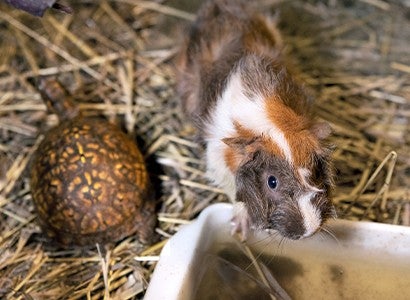Goblin might not have lasted much longer at Tim’s Reptiles and Exotics in Pulaski County, Kentucky. The sulcata tortoise was one of about 150 animals rescued in September from nightmarish conditions at the pet store when local police arrested the store operator on 19 counts of animal cruelty.
Responders from the Humane Society of the United States and other organizations found neglected rabbits, turtles, guinea pigs, snakes and other animals living in filthy, cobweb-filled cages with no access to food or clean water. After the store operator surrendered the animals to the police, several animal welfare groups provided care and rehabilitation, preparing the eligible pets for adoption.
On the day of the seizure, Goblin repeatedly walked toward the store’s door as it opened, apparently seeking fresh air. Today, he’s got plenty of that. Goblin roams a large yard at Wildlife Matters Rehabilitation Haven, a nonprofit sanctuary in Nancy, Kentucky, spending hours in the sunshine each day and interacting with the sanctuary’s six other tortoises. He has fresh grass and clover to graze and gets fresh fruits and vegetables, says sanctuary vice president Otis Moore, who estimates Goblin’s age at 12 to 15 years. (Tortoises can live for more than 100 years!)
50,000+ animals have been rescued from cruelty and disasters by our U.S.-based team since 2010.
Goblin’s happy ending almost didn’t happen. When rescuers found him, he was dehydrated and covered in his own excrement, with shell rot on his underside and infections in both eyes. Tortoises are natural diggers, but with no ground to dig in at the pet store, Goblin’s nails had curved into the pads of his feet; Moore had to trim his nails with a rasp. Given his shell size, Goblin should have weighed about 50 pounds, but upon arrival was only 27 pounds. At about half his ideal body weight, Moore says, Goblin’s days were numbered.
But he took right to eating at the sanctuary, Moore says, and by early December Goblin was up to 48 pounds. “It’s a miracle that he’s even alive,” Moore says.
Moore’s dream is to transfer Goblin to a wildlife reserve in West Africa. “With the life he’s had, he deserves to finish it out in his native land.”

Four guinea pigs from the seizure found homes far from Kentucky in the Washington, D.C. metro area, thanks to Elaine Fuerniss of Bourbon County Rescue—which is based in Paris, Kentucky and holds adoption events in Frederick, Maryland.
Want more content like this?
This was written and produced by the team behind All Animals, our award-winning magazine. Each issue is packed with inspiring stories about how we are changing the world for animals together.
Learn MoreSubscribe

